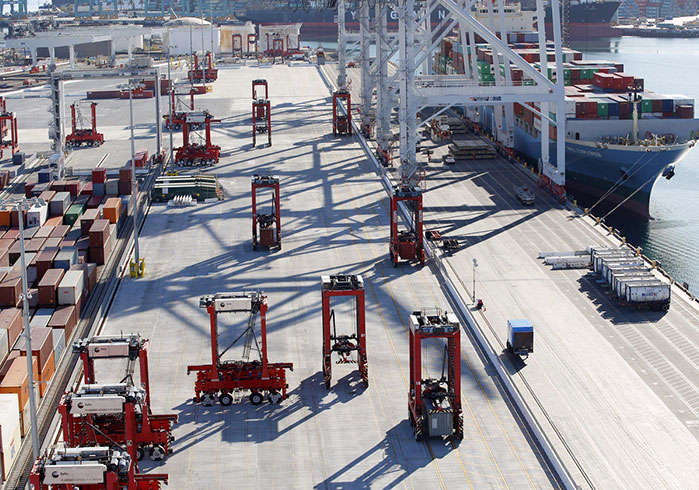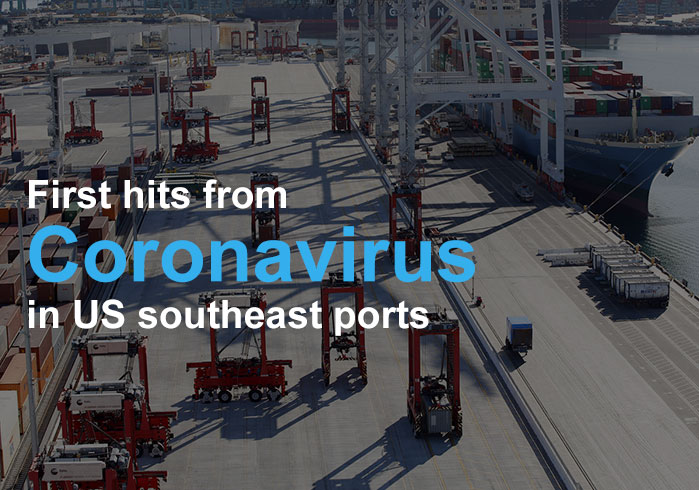
As news of the Coronavirus escaped China, so did the virus itself in the form of a dormant virus lying within unsuspecting hosts. It has an unusually long incubation period, 14 days on average, during which time the host has no symptoms. Similar to the common flu, but elongated, China and nearby areas had no choice but to quarantine once the issue made itself known on a global scale. Since that time, there have been severe declines in work and shipments from the affected areas.
Major ports all along the U.S. Southeast are bracing for what is likely to become double-digit declines thanks to the virus, declines that are scheduled to be felt primarily during March and April, as a result of longer transit times from Asia.
Cargo volume decreases from Coronavirus
The decreases from Coronavirus shipments have been felt all over the world, and especially the United States. But where has it impacted? Almost everywhere, west and east coast ports alike are starting to feel the impact of the delay.
Savannah is soon to feel the biggest brunt of this quarantine and panic, as it accounts for the highest number of weekly Asian shipping services in the area and is, in fact, the first port of call for any trans-Pacific routes that go through the Panama Canal.
In 2019, for example, China accounted for $19.8B worth of imports to Savannah. That figure is not an anomaly either; for the last five years, the Georgia Department of Economic Development has averaged $20.8B in imports, which makes that Asian total twice that of Georgia’s next highest trading partner: Germany. Imports from China are three times higher than the second-largest Asian based trading partner, South Korea.
It is unclear whether this virus will continue to alter the currently mid-single-digit rate in the coming 2020 months, but everyone is on the edge of their seats.
Virginia Impact
In the state of Virginia, there has already been an impact. There has been a decline in large part because Virginia works in tandem with South Carolina to accept 22% of the imports coming from Asia to the East Coast. It is expected that the majority of the material impact for the annual cargo through Virginia will hit between February and April. In January alone, container units declined 5.9%, but an even steeper drop is in the future.
The Virginia Port Authority estimates that losses will include 44,000 import containers in total, which will be a significant drop. This would be equal to an 11% decline for pier container traffic.
South Carolina Decline
South Carolina is no less immune. As mentioned, in conjunction with the state of Virginia, South Carolina assumes 22% of all imports coming from Asia. Their losses have been quite severe. South Carolina anticipates a 15% drop in volume between March and April, but if regular trade resumes, a return to normal flows in May and June. It was optimistic to believe that the factories would reopen at the end of the Chinese New Year and put an end to the blank sailings, but people still held out hope, until now though.
South Carolina, however, is prepared for a scenario like this, and they have chassis available for business when the beneficial cargo owners need someone to tide them over when those regular trade routes resume. South Carolina is confident their port can handle the upcoming burst of activity later in the year when it happens.
Los Angeles and Long Beach Decline
On the West Coast, there are changes too. Because of shorter transit times between Asia and the West Coast, these impacts were already felt in Los Angeles and Long Beach. A delay in the reopening for Chinese factories will be felt immediately on the West Coast rather than the East Coast because of the shorter transit times.
Port officials in both forecasts declined around 12-15% for container volume for this first quarter. Moreover, the Port of Los Angeles has projected amounts will decrease by 25% for February and 15% for the first quarter in total.
Long Beach port authorities are estimating a drop in volume around 6% in February and a total of 12% during the entire quarter. South Korea and China are two of the largest trading partners for Long Beach, so the impact of Coronavirus will be felt here quite heavily too.
Blank Sailing Effect on Projected Volumes
Blank sailings have the most significant effect on both areas. It is the blank sailings that are contributing to the projected decline in total volume. It is estimated that 40 blank sailings will continue along with the West Coast ports of Los Angeles and Long Beach, for example.
How Shippers Can Prepare
As a result of these losses, port authorities and those shippers operating in them, need to finely tune their systems and regularly perform maintenance to prepare for such changes. Shippers must continue to adjust for significant losses, primarily if they are operating in the Southeast U.S. ports, and anticipate a drop in total volume for the entire first quarter. It was only the South Carolina Port Authority that assumed a snapback to regular trade flows in May and June. Still, all shippers can expect things will head in that direction until something happens in the news to dictate otherwise. Making adjustments in shipments, customer expectations, and accounting can prevent companies from being too severely and surprisingly impacted by the continued decline in trade and the continued increase in blank sailings between China and other areas of Asia. Those working with ports along the west coast are going to feel it about a month sooner than those on the East Coast, another data point to take into account.


